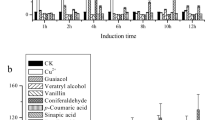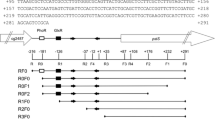Abstract
The acoABCL and acuABC operons of Bacillus licheniformis DSM13 are strongly induced at the transcriptional level during glucose starvation conditions. Primer extension analyses of this study indicate that the acoABCL operon is controlled by a sigmaL-dependent promoter and the acuABC operon by a sigmaA-dependent promoter. Transcription at the acoA promoter is repressed by glucose but induced by acetoin as soon as the preferred carbon source glucose is exhausted. The acuA promoter shows a similar induction pattern, but its activity is independent from the presence of acetoin. It is demonstrated that the acoABCL operon is mainly responsible for acetoin and 2,3-butanediol degradation in B. licheniformis.







Similar content being viewed by others
References
Ali NO, Bignon J, Rapoport G, Debarbouille M (2001) Regulation of the acetoin catabolic pathway is controlled by sigma L in Bacillus subtilis. J Bacteriol 183:2497–2504
Choi SK, Saier MH (2005) Regulation of sigL expression by the catabolite control protein CcpA involves a roadblock mechanism in Bacillus subtilis: potential connection between carbon and nitrogen metabolism. J Bacteriol 187:6856–6861
Clements LD, Streips UN, Miller BS (2002) Differential proteomic analysis of Bacillus subtilis nitrate respiration and fermentation in defined medium. Proteomics 2:1724–1734
Gardner JG, Escalante-Semerena JC (2008) Biochemical and mutational analyses of AcuA, the acetyltransferase enzyme that controls the activity of the acetyl coenzyme A synthetase (AcsA) in Bacillus subtilis. J Bacteriol 190:5132–5136
Gardner JG, Escalante-Semerena JC (2009) In Bacillus subtilis, the sirtuin protein deacetylase, encoded by the srtN gene (formerly yhdZ), and functions encoded by the acuABC genes control the activity of acetyl coenzyme a synthetase. J Bacteriol 191:1749–1755
Gardner JG, Grundy FJ, Henkin TM, Escalante-Semerena JC (2006) Control of acetyl-coenzyme A synthetase (AcsA) activity by acetylation/deacetylation without NAD(+) involvement in Bacillus subtilis. J Bacteriol 188:6715–6715
Grundy FJ, Turinsky AJ, Henkin TM (1994) Catabolite regulation of Bacillus subtilis acetate and acetoin utilization genes by Ccpa. J Bacteriol 176:4527–4533
Höhn-Bentz H, Radler F (1978) Bacterial 2, 3-butanediol dehydrogenases. Arch Microbiol 116:197–203
Hoi LT (2006) Genome-wide analysis of nutrient starvation responses of Bacillus licheniformis. Dissertation, University of Greifswald, Greifswald, Germany
Horinouchi S, Weisblum B (1982) Nucleotide-sequence and functional map of PE194, a plasmid that specifies inducible resistance to macrolide, lincosamide, and streptogramin type-B antibiotics. J Bacteriol 150:804–814
Huang M, Oppermann-Sanio FB, Steinbüchel A (1999) Biochemical and molecular characterization of the Bacillus subtilis acetoin catabolic pathway. J Bacteriol 181:3837–3841
Jürgen B, Barken KB, Tobisch S, Pioch D, Wumpelmann M, Hecker M, Schweder T (2005) Application of an electric DNA-chip for the expression analysis of bioprocess-relevant marker genes of Bacillus subtilis. Biotechnol Bioeng 92:299–307
Kunst F, Ogasawara N, Moszer I, Albertini AM, Alloni G, Azevedo V, Bertero MG, Bessières P, Bolotin A, Borchert S, Borriss R, Boursier L, Brans A, Braun M, Brignell SC, Bron S, Brouillet S, Bruschi CV, Caldwell B, Capuano V, Carter NM, Choi SK, Codani JJ, Connerton IF, Danchin A (1997) The complete genome sequence of the Gram-positive bacterium Bacillus subtilis. Nature 390:249–256
Liebeke M, Brozel VS, Hecker M, Lalk M (2009) Chemical characterization of soil extract as growth media for the ecophysiological study of bacteria. Appl Microbiol Biotechnol 83:161–173
Manners DJ (1962) Enzymic synthesis and degradation of starch and glycogen. Adv Carbohydr Chem 17:371–430
Nicholson WL (2008) The Bacillus subtilis ydjL (bdhA) gene encodes acetoin reductase/2, 3-butanediol dehydrogenase. Appl Environ Microbiol 74:6832–6838
Ramos HC, Hoffmann T, Marino M, Nedjari H, Presecan-Siedel E, Dreesen O, Glaser P, Jahn D (2000) Fermentative metabolism of Bacillus subtilis: physiology and regulation of gene expression. J Bacteriol 182:3072–3080
Rey MW, Ramaiya P, Nelson BA, Brody-Karpin SD, Zaretsky EJ, Tang M, Lopez de Leon A, Xiang H, Gusti V, Clausen IG, Olsen PB, Rasmussen MD, Andersen JT, Jørgensen PL, Larsen TS, Sorokin A, Bolotin A, Lapidus A, Galleron N, Ehrlich SD, Berka RM (2004) Complete genome sequence of the industrial bacterium Bacillus licheniformis and comparisons with closely related Bacillus species. Genome Biol 5:R77
Sambrook J, Fritsch E, Maniatis T (1989) Molecular cloning: a laboratory manual, 2nd edn. Cold Spring Harbor Laboratory Press, Cold Spring Harbor
Sanger F, Nicklen S, Coulson AR (1977) DNA sequencing with chain-terminating inhibitors. Proc Natl Acad Sci USA 74:5463–5467
Schallmey M, Singh A, Ward OP (2004) Developments in the use of Bacillus species for industrial production. Can J Microbiol 50:1–17
Shin BS, Choi SK, Park SH (1999) Regulation of the Bacillus subtilis phosphotransacetylase gene. J Biochem 126:333–339
Silbersack J, Jurgen B, Hecker M, Schneidinger B, Schmuck R, Schweder T (2006) An acetoin-regulated expression system of Bacillus subtilis. Appl Microbiol Biotechnol 73:895–903
Starai VJ, Escalante-Semerena JC (2004) Acetyl-coenzyme A synthetase (AMP forming). Cell Mol Life Sci 61:2020–2030
Stülke J, Hillen W (2000) Regulation of carbon catabolism in Bacillus species. Annu Rev Microbiol 54:849–880
Tschech A, Pfennig N (1984) Growth yield increase linked to caffeate reduction in Acetobacterium woodii. Arch Microbiol 137:163–167
Veith B, Herzberg C, Steckel S, Feesche J, Maurer KH, Ehrenreich P, Bäumer S, Henne A, Liesegang H, Merkl R, Ehrenreich A, Gottschalk G (2004) The complete genome sequence of Bacillus licheniformis DSM13, an organism with great industrial potential. J Mol Microbiol Biotechnol 7:204–211
Voigt B, Schweder T, Becher D, Ehrenreich A, Gottschalk G, Feesche J, Maurer KH, Hecker M (2004) A proteomic view of cell physiology of Bacillus licheniformis. Proteomics 4:1465–1490
Voigt B, Hoi LT, Jürgen B, Albrecht D, Ehrenreich A, Veith B, Evers S, Maurer KH, Hecker M, Schweder T (2007) The glucose and nitrogen starvation response of Bacillus licheniformis. Proteomics 7:413–423
Voigt B, Antelmann H, Albrecht D, Ehrenreich A, Maurer KH, Evers S, Gottschalk G, van Dijl JM, Schweder T, Hecker M (2009) Cell physiology and protein secretion of Bacillus licheniformis compared to Bacillus subtilis. J Mol Microbiol Biotechnol 16:53–68
Waschkau B, Waldeck J, Wieland S, Eichstadt R, Meinhardt F (2008) Generation of readily transformable Bacillus licheniformis mutants. Appl Microbiol Biotechnol 78:181–188
White D (2007) Central metabolic pathways. The physiology and biochemistry of prokaryotes, 3rd edn. Oxford University Press, New York, pp 196–228
Yon J, Fried M (1989) Precise gene fusion by PCR. Nucleic Acids Res 17:4895–4895
Acknowledgements
This work was supported by a scholarship from the Ministry of Education and Training of Vietnam (MOET) and the Institute of Marine Biotechnology (IMaB) to Trung Nguyen Thanh. Results of this study were generated in the frame of the Competence Network “Genome Research on Bacteria” financed by the German Federal Ministry of Education and Research (BMBF) (BiotechGenomik 0313751B and GenomikDesign). We thank Friedhelm Meinhardt for providing the MW3 mutant strain. We also thank Hoi Le Thi for her support in vector constructions.
Author information
Authors and Affiliations
Corresponding author
Rights and permissions
About this article
Cite this article
Thanh, T.N., Jürgen, B., Bauch, M. et al. Regulation of acetoin and 2,3-butanediol utilization in Bacillus licheniformis . Appl Microbiol Biotechnol 87, 2227–2235 (2010). https://doi.org/10.1007/s00253-010-2681-5
Received:
Revised:
Accepted:
Published:
Issue Date:
DOI: https://doi.org/10.1007/s00253-010-2681-5




